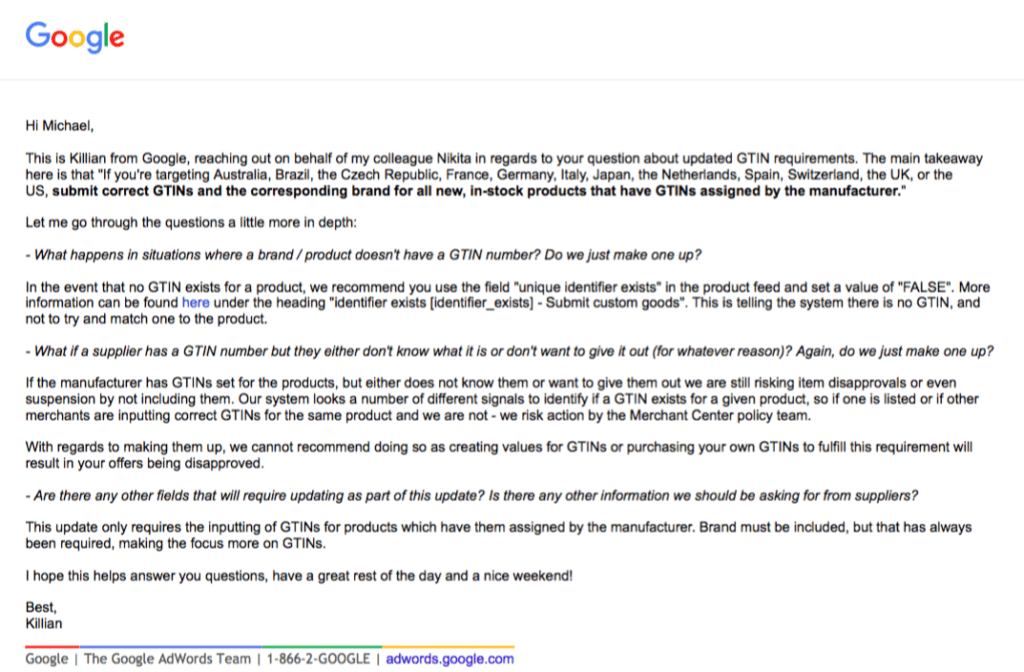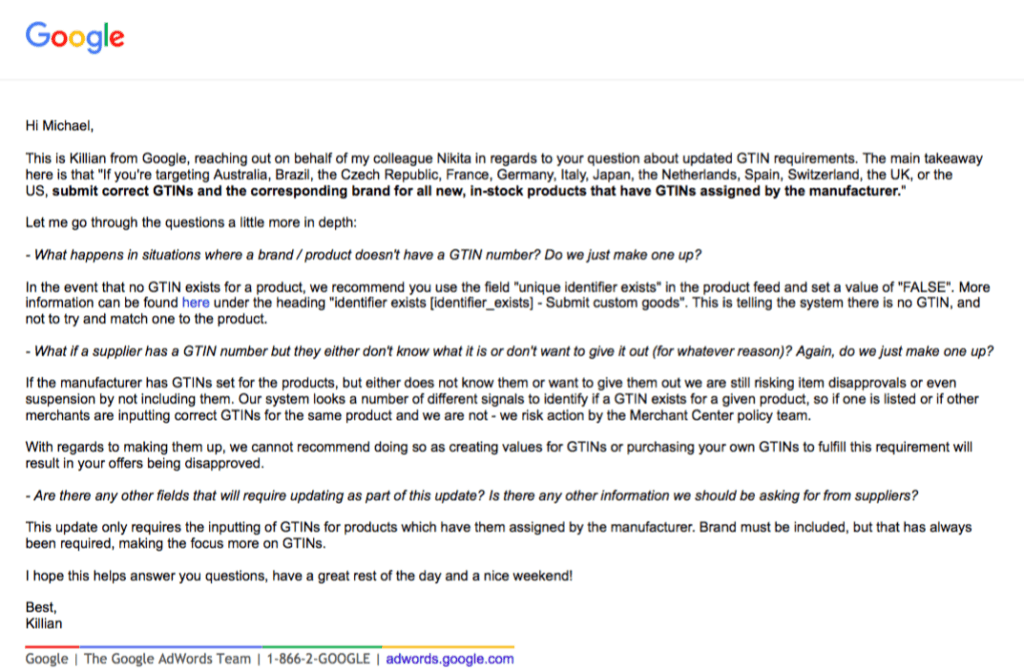
Back in February of this year, Google announced an update to the list of requirements for your Product Listing Ads (PLA) – also known as your shopping feed. Originally this was trialled with a list of just 50 brands, but Google has now decided to roll this out as a blanket rule, leaving many ecommerce retailers scrambling to get everything sorted before the May 16th deadline.
This post will cover what a GTIN number is, why it’s important and what to do about it. If you already know the basics, I suggest skipping further down the article where I’ll tell you what is expected of you and how to make the changes that are expected of you.
What Is A GTIN?
GTIN stands for “Global Trade Item Number”. It is, essentially, a fingerprint for each SKU. It’s a unique numerical identifier that a manufacturer will assign to each SKU, and Google uses it to figure out what it is you’re actually selling. In turn, this allows them to classify and then display products relevant to a user’s search query. Assuming a product has a GTIN number, the easiest way to find it is by looking next to the barcode of that product.
Who Will This Affect?
Well, for starters:
“If you sell brand-name products that are sold by multiple merchants, you should take a close look at the new requirements and double-check that your product data is correct and up-to-date.”
And secondly:
“Advertisers must submit the correct GTINs and the corresponding brand for all new, in-stock products that have GTINs assigned by the manufacturer if they are targeting consumers in Australia, Brazil, Czech Republic, France, Germany, Italy, Japan, the Netherlands, Spain, Switzerland, United Kingdom and the United States.”
But there are exceptions:
“If you sell used, custom, handmade, or vintage products, this change probably won’t impact you. You can still improve your ad performance by adding unique product identifiers to your product data where they’re available.”
That means that if what you’re selling falls into any of these categories, you’re allowed to fill in the GTIN field with ‘identifier exist= false’. That will let Google know that there’s no product code for this product.
Why Is Google Doing This?
“When we understand what you’re selling, we can help boost your ad performance by adding valuable details about the product and serving the ad in a more relevant way to users. This also means that your ads can serve in more places on Google, YouTube, and our partner sites.”
Cutting through the fat, Google makes its money by connecting searchers to whatever it is they need. What has made them such a powerhouse is the level of relevancy between the user’s search query and the results they get served with. The GTIN code is the next step in the relevancy evolution.
Google’s ability to identify and classify your product means they’re able improve the relevancy of the content they present for each search query. In turn, this increases the chances of a consumers engaging with and buying a product.
What Should I Do?
If you fall into the “I need a GTIN category”, you should be reaching out to the product manufacturer or supplier and ask them to provide that information. Alternatively, you can get try to get all of your GTIN numbers using the below strategies:
- Your supply chain system – you might already be using a GTIN in your warehousing, inventory or fulfilment system.
- Your drop ship suppliers – If you don’t actually hold the stock you’re listing, just ask your supplier to add the GTIN to any product data they give you.
- Products in your inventory – if a product has a GTIN number, then you’ll find the number just below the bar code. Admittedly this is an incredibly manual (and in many cases unrealistic) process.
If you want more information, I recommend visiting Google’s support page and reading it in detail.
I also contacted Google directly to get some more clarity on a few questions our clients raised with us. You can see the questions and the recommended course of action below:


The Consequences
In short, if you fail to include a GTIN number in your product feed, Google will remove those products from the feed until you update it. A workaround many retailers used previously was by filling in the GTIN field with ‘identifier exist= false’, but Google has made it very clear that this won’t be possible anymore.
Google is once again reminding all of us that quality data – and their ability to leverage it – is going to determine the future of the search engine results pages. For retailers, brands and distributors, this might feel like just another hurdle they have to jump through to keep their digital storefront open for business. But for the consumer, this is another step closer to connecting them with the exact product they want at the exact time they want it.